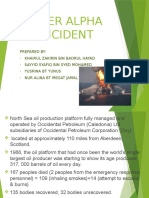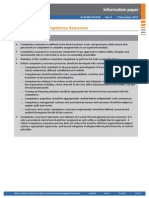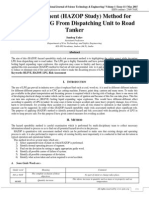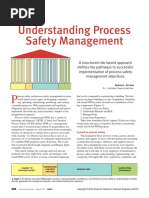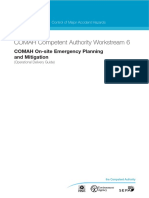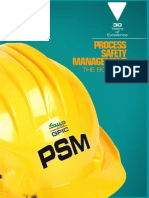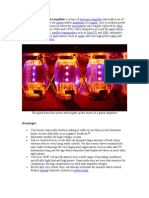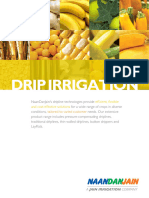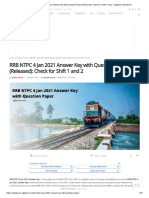What If-Checklist Example
Uploaded by
ltroncosWhat If-Checklist Example
Uploaded by
ltroncos2/1/2005 Letter of Interpretation to Mr.
Roygene Harmon
Appendix Example Application of 1910.119(e)(3)(vii) Below are excerpts from two different PHA methodologies [What-If Checklist (Figure 1) and HAZOP (Figure 2)]. Each PHA excerpt identifies one hazard/deviation as well as its corresponding engineering and administrative controls, safeguards, recommendation/actions and a quantitative description of consequence, likelihood and the risk priority for the identified hazard. An example (e.g. �) of the application of the specific OSHA 1910.119(e)(3) consequence requirements are identified on the example PHA worksheets. After the PHA worksheet examples, other examples are provided to illustrate how some employers utilize a risk matrix to comply with the qualitative evaluation requirement (1910.119(e)(3)(vii)). As noted earlier, PSM is performance standard, and that these examples may or may not be applicable to your specific situation. The following is an example of the development and use of a risk matrix. First, a qualitative description of consequence and likelihood/frequency of the hazard based on a failure of engineering and/or administrative controls is established. Figure 3 is the Consequence Table. It is a qualitative description of the range of degrees of consequences related to the identified hazard and its associated failure of controls. These consequences range from 1 4, with 4 being the most severe Consequence Class. Figure 4 is the Likelihood Table, it is a qualitative description of the range of likelihood/frequency that an identified engineering or administrative control might fail. The likelihood ranges from 1 4, with 4 being the most likely to fail. Using the Consequence and Likelihood Class numbers a Risk Priority Matrix (Figure 5) can be constructed. The Risk Priority Matrix is used to identify the Risk Class. Once the Risk Class (e.g. C) is determined from the Risk Priority Matrix, the Risk Class can be correlated to the Risk Priority Legend (Figure 6) which prioritizes the hazard as identified by the PHA team. In this case, the PHA team enters the evaluated Consequence Class, Likelihood Class, and Risk Class on the PHA worksheets, Figures 1 and 2. In the following example PHA worksheets the abbreviations and symbols mean: C = Consequences Class L = Likelihood Class R = Risk Priority Class
� - 1910.119(e)(3)(i): � - 1910.119(e)(3)(iii): � - 1910.119(e)(3)(iv): � - 1910.119(e)(3)(vii):
address the hazards of the process address engineering and administrative controls applicable to the hazards address consequence of failure of engineering and administrative controls address a qualitative evaluation of a range of possible safety and health effects of failure of controls
2/1/2005 Letter of Interpretation to Mr. Roygene Harmon
Figure 1 - Example Worksheet Excerpt from What If/Checklist PHA Methodology C= Consequence Class, L= Likelihood Class, R = Risk Class What If Consequences/ Safeguards C L R Recommendations/ Hazard Action Emergency Shutdown Valve 23 (ESD - 23) fails to close when needed? (This can occur due to extremely cold weather, reliability due to inspection/ testing/maintenance or design problems) Release of highly flammable materials in the operating area. Potential for fire/explosion with employee injuries/fatalities 1. Specific Inspection/testing/ maintenance program for ESDs 2. Valve actuator sizing 3. ESD-23 is fail closed design 4 2 B 1. Due to cold weather modify MI procedures � to increase ESD valve testing to 1/2wks. 2. Inspection records for ESD 23 not in file, follow-up to assure ESD-23 inspected as required by MI procedures 3. No equipment data sheet was found for actuator for ESD-23, follow-up with engineering to assure design is correct. 4. Consider over sizing valve actuator Figure 2 - Example Excerpt from HAZOP PHA Methodology C= Consequence Class, L= Likelihood Class, R = Risk Class Causes Consequences Safeguards Recommendations/ C L R Actions Agitator Un-reacted HHC in HHC detector 1. Consider adding 4 2 B motor fails the reactor carried and alarm alarm/shutdown of the over to Storage Tank system for loss of ��� Electrical 3 (ST-3) and is agitation to the � utility lost released to the reactor enclosed work area. Agitator Probable injuries or 2. Ensure adequate mechanical fatalities to workers ventilation exists for linkage fails due to highly acute enclosed work area toxic material hazard and/or use an Operator enclosed ST-3 fails to � activate 3. Update PSI file and agitator Op. Procedure HHC-39 to include consequence of �� deviation, engineering controls including safety system information, e.g. SIS and emergency ventilation
��
��
��
Deviation Loss of Agitation
2/1/2005 Letter of Interpretation to Mr. Roygene Harmon
Consequence Class 1 2 3 4
Figure 3 - Consequence Table Qualitative Employee Safety Consequence Criteria No employee injuries One Loss Time Injury or Illness Multiple Lost Time Injuries or Illnesses Multiple Lost Time Injuries or Illnesses w/one or more fatalities Figure 4 - Likelihood Table Qualitative Likelihood Criteria Not expected to occur during the lifetime of the process. Examples Simultaneous failures of two or more independent instrument or mechanical systems Expected to occur only a few times during the life of the process. Examples Rupture of product piping, trained employees w/procedures injured during LOTO operation Expected to occur several times during the life of the process. Examples hose rupture, pipe leaks, pump seal failure Expected to occur yearly. Examples - instrument component failures, valve failure, human error, hose leaks
Likelihood Class 1
Figure 5 - Example Risk Priority Matrix
Consequences
4 3 2 1
C C D D 1
B B C D 2
A B B C 3
A A B C 4
Likelihood
Priority
Risk Class A
Figure 6 - Example Risk Priority Legend Explanation of Risk Risk intolerable - needs to be mitigated within 2 weeks to at least a Class C, if that cannot be accomplished, process needs to be shutdown Risk undesirable - needs to be mitigated within 6 months to at least a Class C Risk tolerable with controls (engineering and administrative) Risk acceptable no further action required
B C D
You might also like
- Case Studies Involving Incidents in A Manufacturing PlantNo ratings yetCase Studies Involving Incidents in A Manufacturing Plant28 pages
- Laerdal Infant Airway Management TrainerNo ratings yetLaerdal Infant Airway Management Trainer7 pages
- How Do You Maintain Process Safety in Times of Change?No ratings yetHow Do You Maintain Process Safety in Times of Change?4 pages
- Standard Operating Procedure 8-24-2014 PDF100% (1)Standard Operating Procedure 8-24-2014 PDF17 pages
- Styrene Vapour Release Incident at LG Polymers: Harikrishnan MNo ratings yetStyrene Vapour Release Incident at LG Polymers: Harikrishnan M32 pages
- Piper Alpha Accident A Summary of IChemE PerspectiveNo ratings yetPiper Alpha Accident A Summary of IChemE Perspective5 pages
- Introduction To Process Safety Identification of Hazards and Critical ControlsNo ratings yetIntroduction To Process Safety Identification of Hazards and Critical Controls25 pages
- Proactive Performance Indicators: Taproot Summit Best Practices - 28 Oct 2010No ratings yetProactive Performance Indicators: Taproot Summit Best Practices - 28 Oct 201035 pages
- Designing Risk Matrices To Avoid Risk Ranking Reversal ErrorsNo ratings yetDesigning Risk Matrices To Avoid Risk Ranking Reversal Errors6 pages
- 5 Day Course Outline of Process Safety Related TopicsNo ratings yet5 Day Course Outline of Process Safety Related Topics3 pages
- Journal of Loss Prevention in The Process Industries: Paul BaybuttNo ratings yetJournal of Loss Prevention in The Process Industries: Paul Baybutt8 pages
- N 06300 IP1038 Human Factors Competancy Assurance Rev 0 Dec 2012 PDFNo ratings yetN 06300 IP1038 Human Factors Competancy Assurance Rev 0 Dec 2012 PDF12 pages
- Risk Engineering Position Paper 04 Process Safety Performance Indicators 2015No ratings yetRisk Engineering Position Paper 04 Process Safety Performance Indicators 201521 pages
- Risk Assessment (HAZOP Study) Method For Decanting LPG From Dispatching Unit To Road Tanker100% (1)Risk Assessment (HAZOP Study) Method For Decanting LPG From Dispatching Unit To Road Tanker4 pages
- Unclassified: Operating Limits and Conditions P-50099No ratings yetUnclassified: Operating Limits and Conditions P-5009917 pages
- Api Performing A Storage Tank Risk Assessment v2No ratings yetApi Performing A Storage Tank Risk Assessment v23 pages
- Overview of Bowtie Methodology of Risk Analysis and Its ApplicationNo ratings yetOverview of Bowtie Methodology of Risk Analysis and Its Application6 pages
- Introduction To Safety Valves Spirax SarcoNo ratings yetIntroduction To Safety Valves Spirax Sarco70 pages
- BakerRisk Best Practice Guidance Document HAZOP 09.2020 FINALNo ratings yetBakerRisk Best Practice Guidance Document HAZOP 09.2020 FINAL24 pages
- Georgia Spill Release Reporting FlowchartNo ratings yetGeorgia Spill Release Reporting Flowchart1 page
- Practical Approach To Managing Safety Critical Equipment and Systems in Process PlantsNo ratings yetPractical Approach To Managing Safety Critical Equipment and Systems in Process Plants10 pages
- Fire Process Safety Newsletter 4th Quarter 2012No ratings yetFire Process Safety Newsletter 4th Quarter 201215 pages
- Chemical Process Quantitative Risk AssesmentNo ratings yetChemical Process Quantitative Risk Assesment189 pages
- Ract No. (If Applicable) :si Gnature: DateNo ratings yetRact No. (If Applicable) :si Gnature: Date8 pages
- Restriction Mapping Sample Question and Its Solution100% (2)Restriction Mapping Sample Question and Its Solution1 page
- Community Service: Subject Code: Mpu3442 Lecturer Name: Muhammad Remy Bin OthmanNo ratings yetCommunity Service: Subject Code: Mpu3442 Lecturer Name: Muhammad Remy Bin Othman26 pages
- RRB NTPC 4 Jan 2021 Answer Key With Question Paper (Released) : Check For Shift 1 and 2No ratings yetRRB NTPC 4 Jan 2021 Answer Key With Question Paper (Released) : Check For Shift 1 and 216 pages
- iSMA-B-MIX38-IP Installation Instruction V4.0No ratings yetiSMA-B-MIX38-IP Installation Instruction V4.02 pages
- Admissions Guidebook For Holders of Diploma or Equivalent Qualifications - 2024 - 2025 - 0No ratings yetAdmissions Guidebook For Holders of Diploma or Equivalent Qualifications - 2024 - 2025 - 0520 pages
- Shelf-Life Expiration Date (SLED) in SAP MMNo ratings yetShelf-Life Expiration Date (SLED) in SAP MM27 pages
- PDF Wildlife Toxicology Emerging Contaminant and Biodiversity Issues 1st Edition Ronald J Kendall download100% (2)PDF Wildlife Toxicology Emerging Contaminant and Biodiversity Issues 1st Edition Ronald J Kendall download67 pages
- SaluEric New An Alluring Imp WPS Office 1No ratings yetSaluEric New An Alluring Imp WPS Office 17 pages
- At The End of This Module, You Should Be Able To: Explain The Eight Stages of Psychosocial DevelopmentNo ratings yetAt The End of This Module, You Should Be Able To: Explain The Eight Stages of Psychosocial Development5 pages











